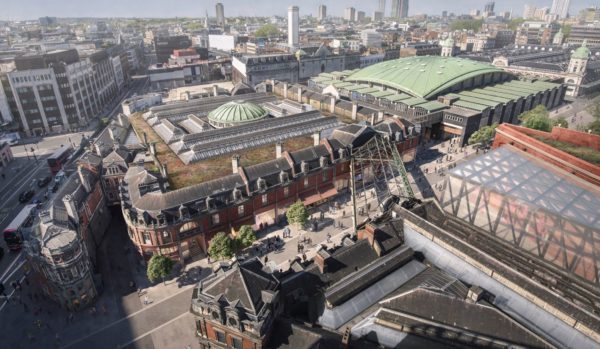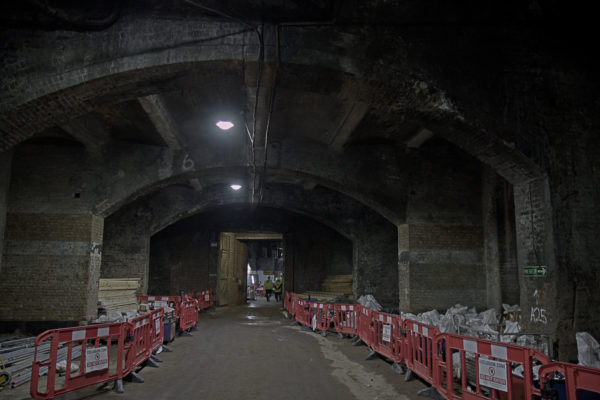The Museum of London is set to close later this year, and will reopen as the renamed The London Museum in a new £337 million home at Smithfield in 2025.
The museum, currently based in a 1970s building at London Wall has been working on redeveloping a cluster of former Smithfield market buildings close to Farringdon for the past few years, but there comes a point when all the historic artefacts need to move from one site to the other, and that process starts next year.
Ahead of the closure, from June 2022, a series of events, activities and displays at the existing Museum of London site will celebrate the museum’s successes over the past 45 years. This will be the very last chance for fans of the Museum of London to visit the museum in its current location before expert curators and conservators carefully relocate the objects to West Smithfield.
The museum will close its doors to the public for the last time in December 2022, although the Museum of London’s second site in Docklands is unaffected and will remain open to visitors.
As a result of the main museum’s move to the larger Smithfield site, The London Museum will be able to open up to millions more visitors and show more of their collection that is currently not possible to display due to lack of space at the current museum site.
They’ve also confirmed that the Cheapside Hoard will go on display in its entirety for the first time when the new museum opens. Only previously shown once in an exhibition in 2013, the Cheapside Hoard is the world’s finest collection of Elizabethan and Jacobean jewellery discovered by chance on a building site.
Preparation work for the new museum has been underway for some years. A team led by Stanton Williams and Asif Khan Studio with Julian Harrap Architects has been working on a masterplan for the reuse and restoration of the existing historic fabric, with contemporary interventions.
Part of the team’s proposals has seen the restoration of the exterior of the General Market building and other areas, with conservation work led by Julian Harrap Architects. This work, the first stage of which is now complete, has seen the grand and historic façades of the General Market brought back to their former glory.
The design and restoration process has uncovered some architectural surprises, including forgotten underground vaults that were part of the former market cold stores, which will be used as interactive exhibition space. This is set to be one of the most atmospheric and evocative parts of the museum.
Another discovery was Lockhart’s Temperance Cocoa Rooms – an establishment that promoted abstinence during the 19th Century. As part of the redevelopment, the Cocoa Rooms will be brought back to life with restored original tiles.
Also forming the perimeter of The London Museum is a ‘museum high street’, a row of terraced houses that will become home to independent shops, cafes, social enterprises and cultural partners.
The museum is reusing the old meat market’s underground spaces, and part of the redevelopment will leave a large glass wall next to the Thameslink railway that runs under the market, so commuters will be able to look into the museum from the trains as they pass by.
Sharon Ament, Director of Museum of London, said: “The countdown starts now. This summer, we’ll be celebrating 45 years at our London Wall site, honouring our great past at the centre of London life before looking forward to being reborn as The London Museum.”
As part of the masterplan for the West Smithfield development, The London Museum plans to further extend its footprint into the adjacent Poultry Market, offering new exhibition space for a rolling programme of temporary exhibitions.
The old museum site is being earmarked for an office development.
Update: 23:30 – corrected number of years the museum is closing to three years.











This sounds so exciting! The logistics for this must be so complicated. Really hope it all goes smoothly. Roll on 2025 😀
Very cautious about this. The site is hugely complex, fragmentary and frankly unattractive. I’ve always had doubts.
3 years to move things and do some light construction work.
In that time other countries would have built new airports, automated high speed rail, networks of electric car chargers, windfarms and solar farms.
The bureaucratic malaise in the UK is appalling. We used to be a country who got things done. We need to get back to a culture of outcomes over unnecessary paperwork.
Fairly obviously it is far more than ‘some light construction work’; have you looked at the area, the buildings or the plans or photos?
Interesting that the museum will be renamed The London Museum as that was the name of one of the collections that came together to form current museum. It was housed at Kensington Palace in the 1950s as its previous venue lost in WW2. The highlight of my childhood visits was the Great Fire diorama.
“Museum of London” is a better name, precise and accurate. Mention “London Museum” and few, particularly outside London, will be sure what you’re talking about.
While it’s nice that it will “open up to millions more visitors”, have any visitors been turned away in the past because of lack of room? (Aside from Covid-related distancing.)
Oh Yes, I remember the Museum being in that location too. I was also mesmerised by the Great Fire of London exhibition display as a child too.
Sounds interesting and good news about the Cheapside Hoard. Lots of effort will have to be made to make people visit this area though. They could form a museum triangle with Charterhouse and The Museum of the Order of St John’s and promote it that way. As it stands the casual tourist would not really visit this area unless major local signage is commissioned. Something artistic at Holborn Circus pointing the way could be a PR coup, and relocate the Prince Albert equestrian statue to somewhere more suitable (and that doesn’t block traffic sight lines as has long been the complaint!) Maybe a statue referencing the Cheapside Hoard, which would be fitting as at the Diamond District. A tie in too with Hatton Gardens.
Curious as to why you think people are willing to visit a museum at London Wall, but wouldn’t visit a museum at Farringdon
Because it is notFarringdon, which for a tourist, if going by tube, can be bothersome and seem out of the way from main tourist sites.
It’s about a 5-minute walk from Farringdon station, with links on the Met, Circle and H&C lines, Thameslink and soon the Elizabeth line — one of the major reasons it was chosen as a location for the museum was the proximity to Farringdon station.
The combination of the London Underground, Thameslink and the Elizabeth line, with over 150 trains per hour passing though at peak times, and connections to three airports, is set to turn Farringdon into one of the busiest interchange stations in London.
It’s extraordinarily well connected to the rest of London by rail.
I have made enquiries and, unlike the present Museum of London, where one can book a Disabled Parking Space in the Basement, the plans make no provision whatsoever for Blue Badge Parking – other than “there will be Disabled Bays in the street outside”.
It seems to me that the people who planned the new museum are treating Disabled people with contempt!
There’s a similar situation at the Docklands Museum where’s no provision for Bookable Disabled Parking.
This makes me extremely depressed.